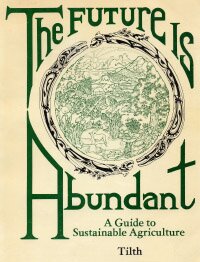
The Future is Abundant
A Guide to Sustainable Agriculture
Tilth Producers of Washington Home | WA Tilth Assoc. | Conference | Directory | Journal | Placement Service | Calendar | Action Alerts
Legislative Update | Bulletin Board | Classifieds | Questions on Agriculture? | Photo Gallery | Links | Contact Us | Join Now | Volunteer

A bioregion, or life-region, is an area which has a unique interlocking web of life distinguishable from that of neighboring regions. A bioregion encompasses watersheds, plants and animals, peoples and tales, past and future. Because of this, a concept closely linked with bioregions is reinhabitation. In Reinhabiting a Separate Country (San Francisco: Planet Drum, 1978) Peter Berg explains that
Reinhabitation means learning to live-in-place in an area that has been disrupted and injured through past exploitation. It involves becoming native to a place through becoming aware of the particular ecological relationships that operate within and around it. It means understanding activities and evolving social behavior that will enrich the life of that place, restore its life-support systems, and establish an ecologically and socially sustainable pattern of existence within it...Useful information for reinhabitants can come from a wide range of sources... Reinhabitants can apply this information toward shaping their own life patterns and establishing relationships with the land and life around them.
The reason the concepts of reinhabitation and bioregionalism are relevant to this book is that in order to begin developing a sustainable agriculture, one needs to recognize and nurture this sense of place, this sense of rootedness and groundedness, this deep understanding of one's environment. And such an understanding is only possible when one's life has a rich, full-bodied context.
To help further the development of such a context, this first chapter provides an overview of the past and present of the Pacific Northwest.
The temperate climate found in the region west of the Cascades, referred to in this book as the Maritime, is unique in North America. It bears more similarity to the climate of parts of Britain and western Europe than it does to most of continental North America, as maritime gardeners quickly learn. For example, the Olympics and the mountains of Vancouver Island receive the highest amount of precipitation of any area in North America -- over 200 inches annually. However, precipitation can vary widely within a small area, as is demonstrated by the rainshadow cast by the high Olympics; precipitation is as low as 15 inches per year in the San Juan Islands.
Amount of precipitation gradually diminishes between the coastal mountains and the Cascades. The western side of the Cascade mountain belt still experiences relatively high precipitation, but the eastern slopes are much drier. Most of the area from the crest of the Cascades to the crest of the Rockies, referred to as the Interior, receives only ten to twenty inches of precipitation annually, with some areas receiving as few as five inches.
The length and intensity of the growing season varies greatly in the Pacific Northwest. Some areas can experience frost every month of the year, while others do so only rarely. Extremely hot summer temperatures in the Columbia and Snake River valleys (up to 115 degrees F) give these areas a higher accumulation of degree-days than any other part of the region. This makes possible the ripening of some crops which cannot ripen in the maritime areas, even though the latter have more frost-free days.
The Rogue River's interior basin has an especially good growing season, situated as it is between the Siskiyous and the southern Cascades. It has hotter and drier weather than any other area west of the Cascades.
Although the general climate patterns of the Pacific Northwest can be helpful in understanding the range in distribution of soil types and vegetation, factors such as variations in local topography may result in variable microclimates within even a small area. It is important to take these local variables into account when designing agriculture landscapes.
Tilth Producers of Washington Home | WA Tilth Assoc. | Conference | Directory | Journal | Placement Service | Calendar | Action Alerts
Legislative Update | Bulletin Board | Classifieds | Questions on Agriculture? | Photo Gallery | Links | Contact Us | Join Now | Volunteer